How to Write a Case Study - All You Wanted to Know

What do you study in your college? If you are a psychology, sociology, or anthropology student, we bet you might be familiar with what a case study is. This research method is used to study a certain person, group, or situation. In this guide from our dissertation writing service , you will learn how to write a case study professionally, from researching to citing sources properly. Also, we will explore different types of case studies and show you examples — so that you won’t have any other questions left.

What Is a Case Study?
A case study is a subcategory of research design which investigates problems and offers solutions. Case studies can range from academic research studies to corporate promotional tools trying to sell an idea—their scope is quite vast.
What Is the Difference Between a Research Paper and a Case Study?
While research papers turn the reader’s attention to a certain problem, case studies go even further. Case study guidelines require students to pay attention to details, examining issues closely and in-depth using different research methods. For example, case studies may be used to examine court cases if you study Law, or a patient's health history if you study Medicine. Case studies are also used in Marketing, which are thorough, empirically supported analysis of a good or service's performance. Well-designed case studies can be valuable for prospective customers as they can identify and solve the potential customers pain point.
Case studies involve a lot of storytelling – they usually examine particular cases for a person or a group of people. This method of research is very helpful, as it is very practical and can give a lot of hands-on information. Most commonly, the length of the case study is about 500-900 words, which is much less than the length of an average research paper.
The structure of a case study is very similar to storytelling. It has a protagonist or main character, which in your case is actually a problem you are trying to solve. You can use the system of 3 Acts to make it a compelling story. It should have an introduction, rising action, a climax where transformation occurs, falling action, and a solution.
Here is a rough formula for you to use in your case study:
Problem (Act I): > Solution (Act II) > Result (Act III) > Conclusion.
Types of Case Studies
The purpose of a case study is to provide detailed reports on an event, an institution, a place, future customers, or pretty much anything. There are a few common types of case study, but the type depends on the topic. The following are the most common domains where case studies are needed:

- Historical case studies are great to learn from. Historical events have a multitude of source info offering different perspectives. There are always modern parallels where these perspectives can be applied, compared, and thoroughly analyzed.
- Problem-oriented case studies are usually used for solving problems. These are often assigned as theoretical situations where you need to immerse yourself in the situation to examine it. Imagine you’re working for a startup and you’ve just noticed a significant flaw in your product’s design. Before taking it to the senior manager, you want to do a comprehensive study on the issue and provide solutions. On a greater scale, problem-oriented case studies are a vital part of relevant socio-economic discussions.
- Cumulative case studies collect information and offer comparisons. In business, case studies are often used to tell people about the value of a product.
- Critical case studies explore the causes and effects of a certain case.
- Illustrative case studies describe certain events, investigating outcomes and lessons learned.
Need a compelling case study? EssayPro has got you covered. Our experts are ready to provide you with detailed, insightful case studies that capture the essence of real-world scenarios. Elevate your academic work with our professional assistance.

Case Study Format
The case study format is typically made up of eight parts:
- Executive Summary. Explain what you will examine in the case study. Write an overview of the field you’re researching. Make a thesis statement and sum up the results of your observation in a maximum of 2 sentences.
- Background. Provide background information and the most relevant facts. Isolate the issues.
- Case Evaluation. Isolate the sections of the study you want to focus on. In it, explain why something is working or is not working.
- Proposed Solutions. Offer realistic ways to solve what isn’t working or how to improve its current condition. Explain why these solutions work by offering testable evidence.
- Conclusion. Summarize the main points from the case evaluations and proposed solutions. 6. Recommendations. Talk about the strategy that you should choose. Explain why this choice is the most appropriate.
- Implementation. Explain how to put the specific strategies into action.
- References. Provide all the citations.
How to Write a Case Study
Let's discover how to write a case study.

Setting Up the Research
When writing a case study, remember that research should always come first. Reading many different sources and analyzing other points of view will help you come up with more creative solutions. You can also conduct an actual interview to thoroughly investigate the customer story that you'll need for your case study. Including all of the necessary research, writing a case study may take some time. The research process involves doing the following:
- Define your objective. Explain the reason why you’re presenting your subject. Figure out where you will feature your case study; whether it is written, on video, shown as an infographic, streamed as a podcast, etc.
- Determine who will be the right candidate for your case study. Get permission, quotes, and other features that will make your case study effective. Get in touch with your candidate to see if they approve of being part of your work. Study that candidate’s situation and note down what caused it.
- Identify which various consequences could result from the situation. Follow these guidelines on how to start a case study: surf the net to find some general information you might find useful.
- Make a list of credible sources and examine them. Seek out important facts and highlight problems. Always write down your ideas and make sure to brainstorm.
- Focus on several key issues – why they exist, and how they impact your research subject. Think of several unique solutions. Draw from class discussions, readings, and personal experience. When writing a case study, focus on the best solution and explore it in depth. After having all your research in place, writing a case study will be easy. You may first want to check the rubric and criteria of your assignment for the correct case study structure.
Read Also: ' WHAT IS A CREDIBLE SOURCES ?'
Although your instructor might be looking at slightly different criteria, every case study rubric essentially has the same standards. Your professor will want you to exhibit 8 different outcomes:
- Correctly identify the concepts, theories, and practices in the discipline.
- Identify the relevant theories and principles associated with the particular study.
- Evaluate legal and ethical principles and apply them to your decision-making.
- Recognize the global importance and contribution of your case.
- Construct a coherent summary and explanation of the study.
- Demonstrate analytical and critical-thinking skills.
- Explain the interrelationships between the environment and nature.
- Integrate theory and practice of the discipline within the analysis.

Lorem ipsum dolor sit amet, consectetur adipiscing elit.

Wednesday Addams
Mysterious, dark, and sarcastic
You’re the master of dark humor and love standing out with your unconventional style. Your perfect costume? A modern twist on Wednesday Addams’ gothic look. You’ll own Halloween with your unapologetically eerie vibe. 🖤🕸️
Need Case Study DONE FAST?
Pick a topic, tell us your requirements and get your paper on time.
Case Study Outline
Let's look at the structure of an outline based on the issue of the alcoholic addiction of 30 people.
Introduction
- Statement of the issue: Alcoholism is a disease rather than a weakness of character.
- Presentation of the problem: Alcoholism is affecting more than 14 million people in the USA, which makes it the third most common mental illness there.
- Explanation of the terms: In the past, alcoholism was commonly referred to as alcohol dependence or alcohol addiction. Alcoholism is now the more severe stage of this addiction in the disorder spectrum.
- Hypotheses: Drinking in excess can lead to the use of other drugs.
- Importance of your story: How the information you present can help people with their addictions.
- Background of the story: Include an explanation of why you chose this topic.
- Presentation of analysis and data: Describe the criteria for choosing 30 candidates, the structure of the interview, and the outcomes.
- Strong argument 1: ex. X% of candidates dealing with anxiety and depression...
- Strong argument 2: ex. X amount of people started drinking by their mid-teens.
- Strong argument 3: ex. X% of respondents’ parents had issues with alcohol.
- Concluding statement: I have researched if alcoholism is a disease and found out that…
- Recommendations: Ways and actions for preventing alcohol use.
Writing a Case Study Draft
After you’ve done your case study research and written the outline, it’s time to focus on the draft. In a draft, you have to develop and write your case study by using: the data which you collected throughout the research, interviews, and the analysis processes that were undertaken. Follow these rules for the draft:

Use Data to Illustrate Key Points in Your Case Study
Even though your case study is a story, it should be based on evidence. Use as much data as possible to illustrate your point. Without the right data, your case study may appear weak and the readers may not be able to relate to your issue as much as they should. Let's see the examples from essay writing service :
With data: Alcoholism is affecting more than 14 million people in the USA, which makes it the third most common mental illness there. Without data: A lot of people suffer from alcoholism in the United States.
Try to include as many credible sources as possible. You may have terms or sources that could be hard for other cultures to understand. If this is the case, you should include them in the appendix or Notes for the Instructor or Professor.
Finalizing the Draft: Checklist
After you finish drafting your case study, polish it up by answering these ‘ask yourself’ questions and think about how to end your case study:
- Check that you follow the correct case study format, also in regards to text formatting.
- Check that your work is consistent with its referencing and citation style.
- Micro-editing — check for grammar and spelling issues.
- Macro-editing — does ‘the big picture’ come across to the reader? Is there enough raw data, such as real-life examples or personal experiences? Have you made your data collection process completely transparent? Does your analysis provide a clear conclusion, allowing for further research and practice?
Problems to avoid:
- Overgeneralization – Do not go into further research that deviates from the main problem.
- Failure to Document Limitations – Just as you have to clearly state the limitations of a general research study, you must describe the specific limitations inherent in the subject of analysis.
- Failure to Extrapolate All Possible Implications – Just as you don't want to over-generalize from your case study findings, you also have to be thorough in the consideration of all possible outcomes or recommendations derived from your findings.
How to Create a Title Page and Cite a Case Study
Let's see how to create an awesome title page.
Your title page depends on the prescribed citation format. The title page should include:
- A title that attracts some attention and describes your study
- The title should have the words “case study” in it
- The title should range between 5-9 words in length
- Your name and contact information
- Your finished paper should be only 500 to 1,500 words in length.With this type of assignment, write effectively and avoid fluff
Here is a template for the APA and MLA format title page:
There are some cases when you need to cite someone else's study in your own one – therefore, you need to master how to cite a case study. A case study is like a research paper when it comes to citations. You can cite it like you cite a book, depending on what style you need.
Citation Example in MLA Hill, Linda, Tarun Khanna, and Emily A. Stecker. HCL Technologies. Boston: Harvard Business Publishing, 2008. Print.
Citation Example in APA Hill, L., Khanna, T., & Stecker, E. A. (2008). HCL Technologies. Boston: Harvard Business Publishing.
Citation Example in Chicago Hill, Linda, Tarun Khanna, and Emily A. Stecker. HCL Technologies.
Case Study Examples
To give you an idea of a professional case study example, we gathered and linked some below.
Eastman Kodak Case Study
Case Study Example: Audi Trains Mexican Autoworkers in Germany
To conclude, a case study is one of the best methods of getting an overview of what happened to a person, a group, or a situation in practice. It allows you to have an in-depth glance at the real-life problems that businesses, healthcare industry, criminal justice, etc. may face. This insight helps us look at such situations in a different light. This is because we see scenarios that we otherwise would not, without necessarily being there. If you need custom essays , try our research paper writing services .
Get Help Form Qualified Writers
Crafting a case study is not easy. You might want to write one of high quality, but you don’t have the time or expertise. If you’re having trouble with your case study, help with essay request - we'll help. EssayPro writers have read and written countless case studies and are experts in endless disciplines. Request essay writing, editing, or proofreading assistance from our custom case study writing service , and all of your worries will be gone.
Don't Know Where to Start?
Crafting a case study is not easy. You might want to write one of high quality, but you don’t have the time or expertise. Request ' write my case study ' assistance from our service.
What Is A Case Study?
How to cite a case study in apa, how to write a case study.

Daniel Parker
is a seasoned educational writer focusing on scholarship guidance, research papers, and various forms of academic essays including reflective and narrative essays. His expertise also extends to detailed case studies. A scholar with a background in English Literature and Education, Daniel’s work on EssayPro blog aims to support students in achieving academic excellence and securing scholarships. His hobbies include reading classic literature and participating in academic forums.

is an expert in nursing and healthcare, with a strong background in history, law, and literature. Holding advanced degrees in nursing and public health, his analytical approach and comprehensive knowledge help students navigate complex topics. On EssayPro blog, Adam provides insightful articles on everything from historical analysis to the intricacies of healthcare policies. In his downtime, he enjoys historical documentaries and volunteering at local clinics.
.webp)

How to Write a Case Study: A Complete Guide with Templates

Writing compelling and insightful case studies is a marketer’s biggest job, yet most get frustrated with this content. The challenge? Figuring out how to write a case study that not only highlights the company’s strongest suit but engages new clients with strategic information. If you often struggle with making case studies as more than just dry facts and figures, you’re leading your efforts to missed opportunities.
How to Write a Case Study Step-by-Step
- Craft a Compelling Headline: Highlight the main success with a clear, direct title.
- Start with a Strong Introduction: Provide a broad overview and hook the reader.
- Discuss Unique Client Challenges: Highlight specific industry-related challenges.
- Highlight the Solution: Showcase your strategies and key results.
- Present Quantifiable Results: Use data and visuals to demonstrate impact.
- Be Clear and Concise: Stick to the point and support claims with data.
- Treat Your Case Study Like a Story: Focus on the customer’s journey and success.
- Use Direct Quotes from the Client: Add authenticity with client testimonials.
- Make the Key Takeaway Clear: Reinforce your expertise and the solution’s value.
- Include a Call to Action (CTA): Guide the reader on what to do next.
- Make It Readable: Use simple language, short paragraphs, and bullet points.
- Finalize and Proofread: Review for errors and ensure a smooth flow.
In this blog, you’ll discover a step-by-step guide that simplifies the process, making it easier to create interesting case studies. From planning to writing, I’ve got you covered. So, let’s start with some basics.
Table of Contents
What is the format of a case study.
- How to Plan a Case Study
How to Write a Case Study
How to summarize a case study, how to cite a case study.
A well-structured case study isn’t just a collection of facts—it’s a powerful marketing tool that tells a compelling story. Using the right format for a case study ensures that your message is clear, engaging, and impactful.
The proper format guides readers through the narrative with hierarchy and scannability, helping them connect with your brand on a deeper level. Most importantly, it empowers you as a marketer to set clear goals for presenting your case studies and ensures you deliver the correct information effectively!
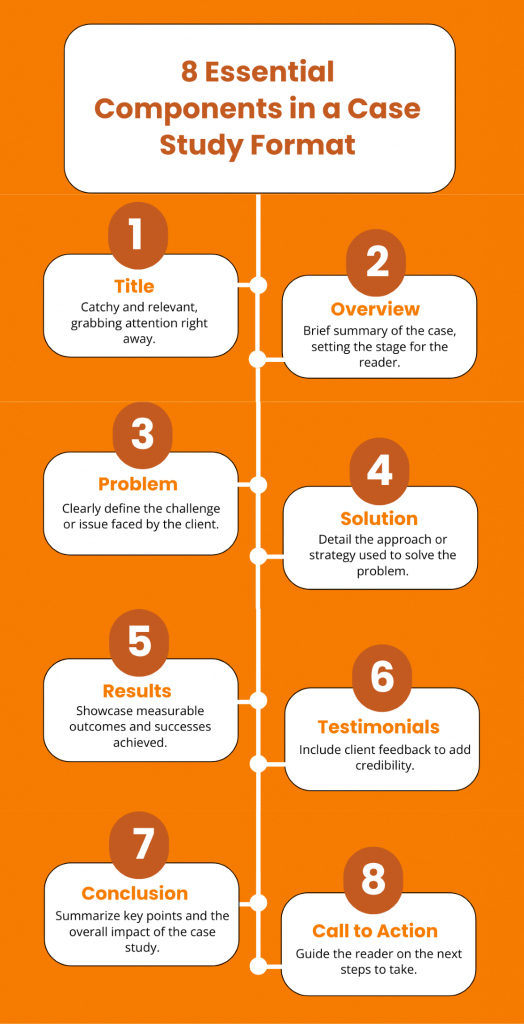
Case studies format helps you to plan and write the case study for your clients. With this outline in mind, you can create steps to complete the process of writing and publishing your case study research. There are eight components of a case study that are essential for building a layout of information in the correct order that makes sense to the viewers.
Start with a catchy “Title” that grabs attention and an “Overview” that sets the stage. Clearly define the “Problem” your client faced, and then showcase your “Solution” in detail. Highlight the success with “Results” that are measurable and impactful. Add authenticity with “Testimonials and Quotes” from satisfied clients. Wrap it up with a firm “Conclusion” and a compelling “Call to Action” in the “About Us” section that guides the reader on what to do next.
By following this format, you create a case study design that resonates with your audience and effectively showcases your brand’s value.
Check out the marketing case study template I’ve included below—it has a clear outline that makes it easy to see how sticking to a format can help you plan and write the entire thing.

How to Plan a Case Study
Now comes the big part! Understanding what to include in a case study outline is just the starting point for beginners. The real challenge lies in creating a step-by-step plan to craft that outline and filling it in with the right information!

1. Set Clear Goals for Your Case Study
Before diving into how to write a case study, defining your ultimate objective is essential. Think about it—what do you want your audience to take away from this case study? For example, your goal is to showcase how your SEO strategies boosted a client’s organic traffic by 150% in just six months. This clear goal will shape your entire narrative and ensure that your case study is laser-focused on demonstrating your expertise and the value you bring.
2. Select a Client that Highlights Your Strongest Suit
Choosing the right client or subject is vital while creating case studies. Imagine you’ve worked with a small e-commerce brand struggling to rank for competitive keywords. Your strategies helped them rank on the first page and increase conversions. This is the perfect client for your case study because their success story directly showcases your SEO prowess.
By picking a client whose experience aligns with your goals, you’ll create a case study that resonates with your target audience.
3. Reach Out to Your Client for Collaboration
Now that you’ve identified the ideal client, it’s time to reach out. Let’s say you contact your client and explain how a case study can highlight their remarkable success story. It’s a great way to spotlight a mutual collaboration based on credibility. Their buy-in is crucial; their insights and data will authenticate your case study.
4. Gather Comprehensive Data and Insights
Data is the lifeblood of any compelling case study. For instance, in your SEO case study, you’ll need to gather data on key metrics like keyword rankings, organic traffic, and conversion rates before and after implementing your strategies. Let’s say your client saw a 50% increase in organic traffic within three months of optimizing their website. Collecting this data will help you build a robust, evidence-based narrative highlighting your impact.
It’s essential to monitor the before-and-after data to track the effectiveness of implementing your strategies.
5. Prepare Insightful Questions and Conduct Interviews
It would be best to ask the right questions to get the most out of your client interviews. Imagine asking your client, “What specific challenges were you facing with your organic search rankings before we started working together?” or “How did our SEO strategies help you achieve your business goals?” These questions will lead to detailed responses that add depth to your case study, making it more than just numbers on a page.
Always ask questions that uncover the key challenges your clients face. This way, your prospects will know when to turn to you to navigate or overcome similar obstacles in their business.
Since I’m giving an example of an SEO case study in marketing, you can try these questions to interview your existing client. Obviously, you can modify the sentences according to your industry basics, but these types of questions are fundamental for collecting structured data from your clients.
- What were your business’s main SEO challenges before we started working together?
- Can you describe your initial expectations for implementing our SEO strategies?
- What specific SEO tactics did we implement that you found most effective?
- How did you monitor and measure the impact of these strategies on your organic traffic?
- What were the key metrics or results that stood out to you after the first three months?
6. Ask Questions That Drive the Story Forward
Impactful questions are the backbone of a strong case study. They allow you to highlight the unique value you delivered to your clients. You can effortlessly showcase your USPs within the case study by asking the right questions.
Focus on inquiring about the effectiveness of your services and strategies, their impact, and which aspects of the solution were most beneficial. This insight will be your key to demonstrating the tangible benefits you offer your clients.
Consider asking questions like:
- Can you share a moment when you first noticed a significant improvement in your website’s organic traffic?
- How did the increase in organic traffic impact other business areas, such as lead generation or sales?
- What feedback did your team or customers receive regarding the changes in your site’s performance?
- Looking back, what do you believe was the most critical factor in achieving these results?
- How has this success with SEO influenced your overall marketing strategy moving forward?
These types of questions encourage clients to share their experiences in a way that paints a vivid picture for your readers, making the case study more relatable and engaging.
7. Draft a Clear and Organized Outline
With all the data and insights gathered, it’s time to create a well-structured case study outline. Let’s say you start with a brief overview of your client’s business and its challenges, followed by a detailed account of the SEO strategies you implemented. Then, you showcase the results with hard data and close with client testimonials and a solid call to action.
As mentioned above, organizing your content in a logical, easy-to-follow format will help you write a case study that not only informs but also captivates your audience.
These steps are the cornerstones of designing a case study. Once you complete this checklist, you can proceed to the next step, which is writing a case study. Since I discussed planning an SEO case study extensively, here is a case study template that perfectly illustrates the process.

You want to create an informative case study for your prospects. But how do you make sure it’s done right? Here’s a step-by-step guide on how to write a case study that drives results.
1. Craft a Compelling Headline
Your headline is the first thing readers see, so make it count! It should grab attention and hint at the success story you’re about to share.
How to Write a Case Study Title:
1. Highlight the Result: Showcase the critical success, like “Increased Sales by 200%.”
2. Be Clear and Direct: Make sure the headline is straightforward to grasp.
3. Use Action Words: Start with strong verbs like “How We” or “Achieved.”
4. Mention Client or Industry: Include relevant details for specificity.
5. Keep It Short: Make it concise and attention-grabbing.
2. Start with a Strong Introduction
Kick off your case study with a broad overview that sets the stage. Provide the big picture and construct a clear narrative that draws readers in, making them eager to learn more about how you solved a significant challenge.
Look at the consulting case study template , which includes a stunning overview description and precise instructions for writing a short and compelling introduction. You can add every little detail to hook the reader.

Get This Template and More
3. Discuss Specific Challenges of Your Client
This is where your prospect can truly connect. By highlighting unique yet specific challenges to their industry, you give them insight into issues they might not have encountered yet—or ones they’ve already faced. This way, they’ll know exactly who to turn to when similar challenges arise.
The following financial case study template provides a brief flow of the company’s common challenges in the financial analysis process. The template is almost ready to use with this domain-specific content, requiring minimal adjustments to design your case study.
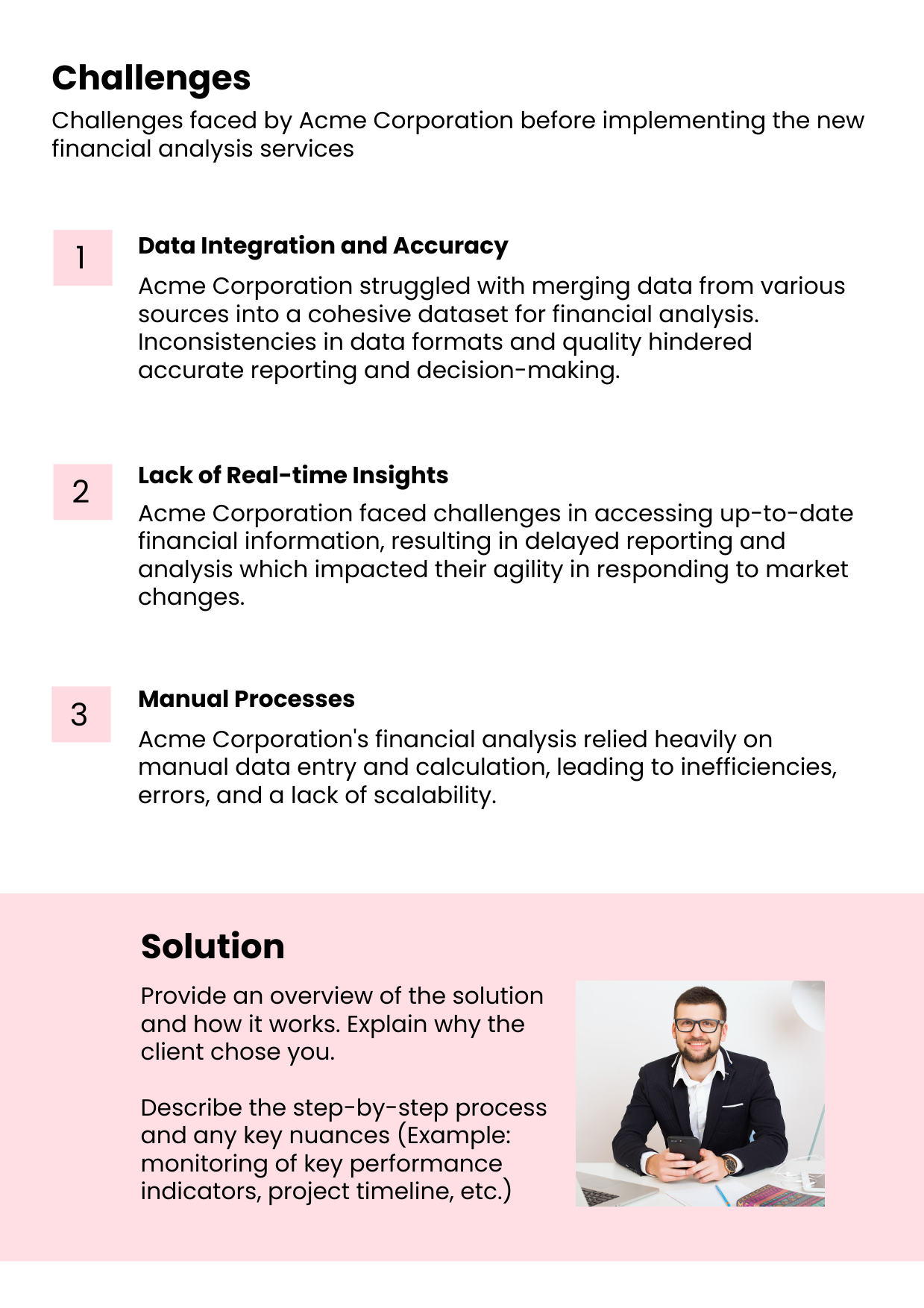
4. Highlight the Solution
Now, dive into the heart of the story. Highlight the solution you provided, and make sure to include a notable achievement or key result. This is your chance to shine!
Check out the format for presenting the implications of your service on your client’s business. The benefits should be well-written and data-driven to convince your upcoming clients. This graphic design case study format helps you understand the specific impacts a company seeks from a reputable graphic design firm.
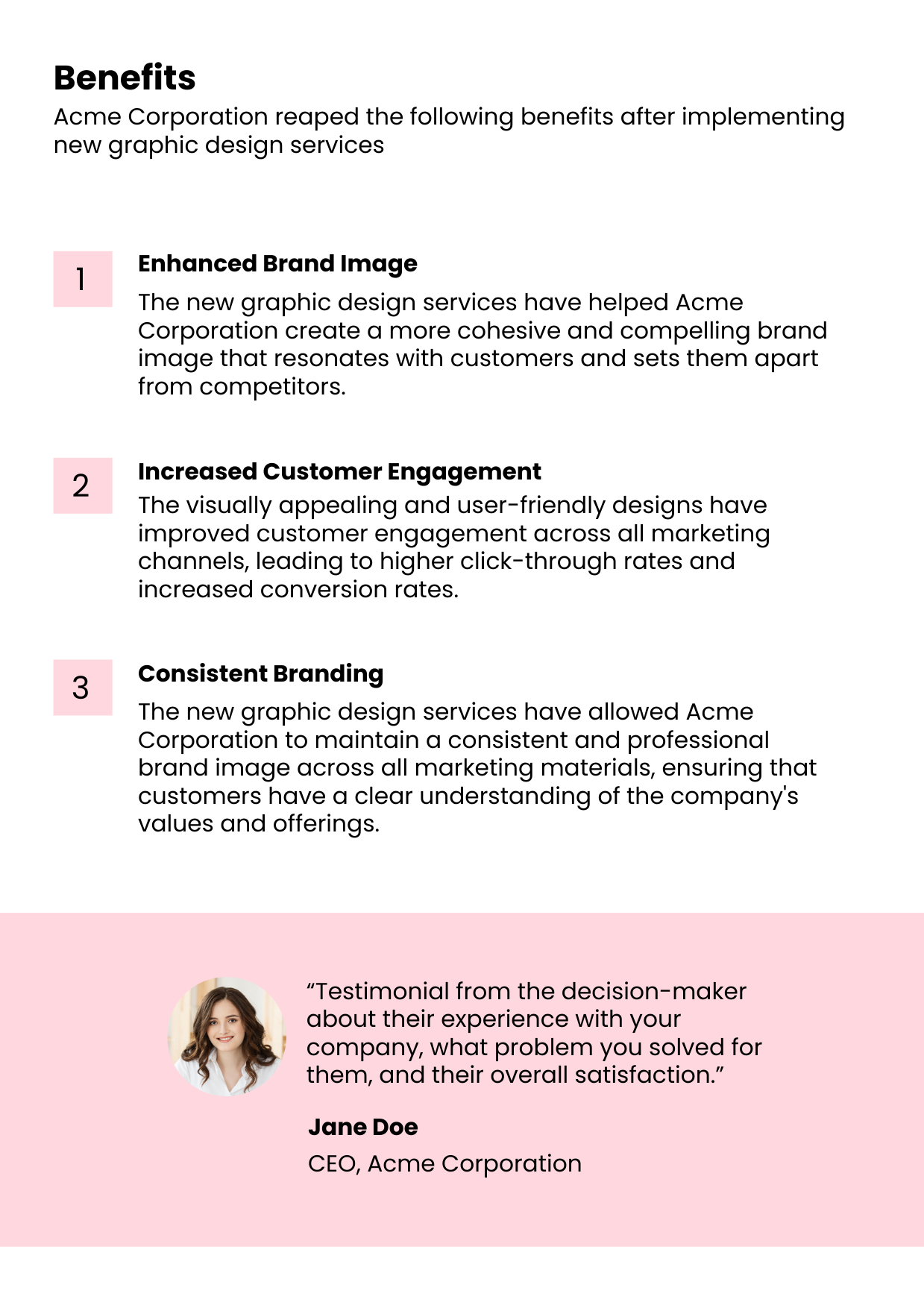
5. Present Quantifiable Results
When sharing the outcome, numbers speak louder than words. Present quantifiable results that clearly demonstrate the impact of your solution. Use graphs or charts to make the data easy to digest and visually appealing.
6. Be Clear and Concise
Less is more. Stick to the point and offer just the right amount of detail to keep your readers engaged. Include data that supports your claims, but avoid overwhelming them with too much information.
Here’s a stunning sales consulting case study that uses a simple case study layout and details written in readable, plain language to gauge more utility.

7. Treat Your Case Study Like a Story
Focus on your customer’s journey. Think of your case study as a story in which your client is the hero, and your solution is the tool that helped them succeed. This approach will make your case study relatable and compelling.
8. Be as Specific as Possible
Don’t be vague—details matter. Mention the specific company and its industry to let your audience know that the challenge and solution are relevant to them. The more precise you are, the more credible and trustworthy your case study will be.
Check out the sample case study below for payroll accounting. The details are clearly organized and grouped to emphasize the type of case study.

Also, the next case study template displays very specific problems that a company faces when it lacks digital marketing expertise.
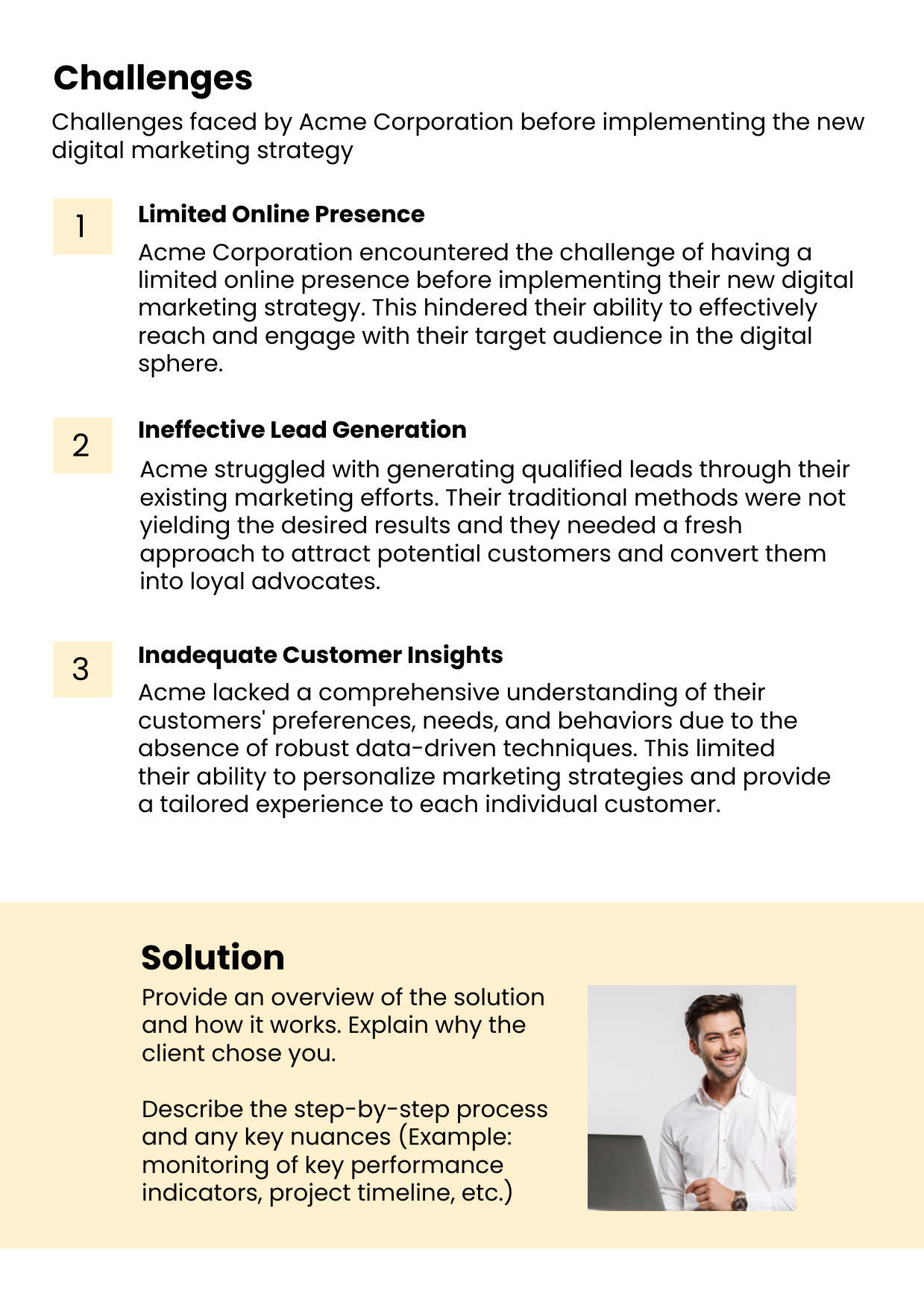
These templates make it a breeze to craft a case study that’s perfect for your niche.
9. Use Direct Quotes from the Client
Quotes from your client add authenticity and credibility. They give readers insight into the client’s perspective and make your case study more relatable. Plus, a glowing testimonial is always a nice touch!
The following inbound marketing case study has a prominent client testimonial. With the brief instructions on this template, it’s easier for you to understand how to capture the golden words of your client and use them as a word-of-mouth strategy within the case study.
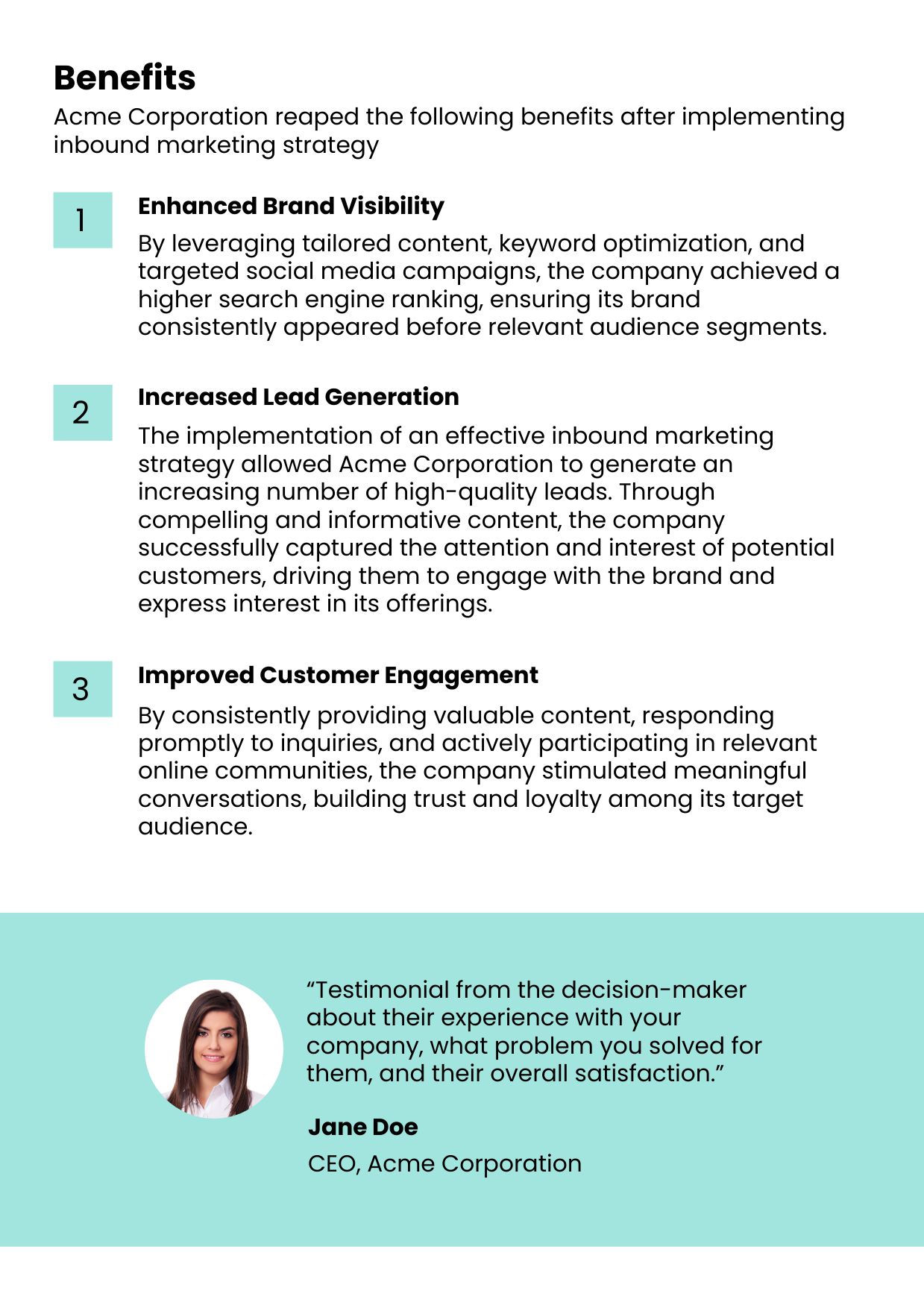
10. Pick an Interesting Angle
Find a unique angle that makes your case study stand out. Maybe it’s an unexpected challenge you overcame, or perhaps it’s a particularly innovative solution. Whatever it is, make it intriguing.
11. Make the Key Takeaway Crystal Clear
Your readers should walk away with a clear understanding of the main point of your case study. This takeaway should reinforce your expertise and the value of your solution.
12. Include a Call to Action (CTA)
Don’t leave your readers hanging—tell them what to do next! Include a compelling summary about your company, showcase your happy client base, and conclude the journey with a strong CTA, whether to contact you for a consultation, download a related resource, or learn more about your services on social media, like the following case study template design.
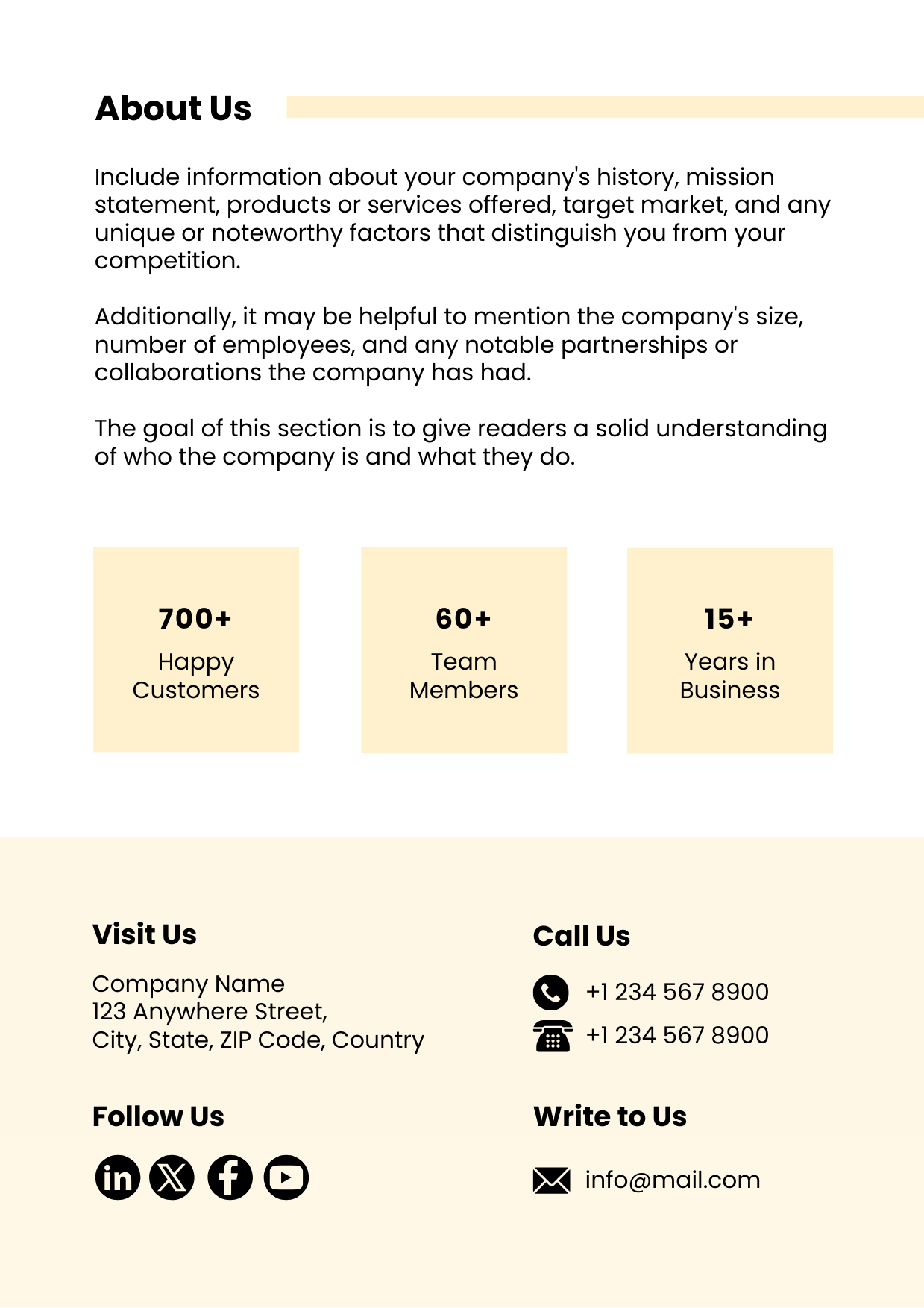
12. Format Professionally
The design of the case study is just as important as the content. A well-formatted, visually appealing document makes a great impression and enhances readability. With ready-to-use niche-oriented templates, you can easily create a professional-looking case study that impresses and converts. Here is an eye-catching template for an AI assistant software case study that displays a sleek and well-navigated format.

13. Make It Readable
Easy readability is key. Use simple language, short paragraphs, and bullet points where appropriate. Your case study should be easy to scan and digest. Follow the thirteen design principles to create a standout piece that enhances your marketing efforts.
To understand this, take a look at the following consulting case study template.

14. Finalize and Proofread Your Case Study
In order to excel in how to write case studies, give your case study a final review before you hit publish. Proofread carefully to catch any typos or errors, and make sure everything flows smoothly. A polished case study reflects your attention to detail and professionalism.
To effectively summarize a case study, start by completing all sections, including the introduction, challenges, solutions, and results. This approach helps marketers identify key points to highlight, making it easier to craft a succinct and engaging summary.
One tricky thing is the length of the case study summary. So, how long should a case study summary be?
The length of a case study summary can vary depending on the details you’re covering. Generally, it should be kept concise, usually spanning a couple of lines or up to a single page with several paragraphs. If you’re crafting a customer case study and want to flex your storytelling muscles, it’s perfectly fine for the summary to stretch to a full page.
If summarizing a case study seems daunting, try DocHipo’s advanced AI Writer tool, which effortlessly creates a crisp and concise summary.
Watch this short video to use it.
This is the last step in writing a case study analysis. Citation in a case study is the practice of giving proper credit to the sources you reference or use in your research. It helps validate your work, shows the depth of your research, and avoids plagiarism. Follow the below steps to cite a case study:
- Identify the Source: Gather details like the author, title, publication year, and where the case study was published.
- Choose a Citation Style: Follow the specific formatting style (APA, MLA, Chicago, etc.) required for your work.
- Format the Citation: Arrange the details according to the chosen citation style.
- Include In-Text Citations: Place citations within the text or paragraphs for the case study.
- Create a References List: At the end of your case study, compile all your sources in a bibliography or reference list.
For case studies, citations in APA and MLA styles are very common. If you are just beginning, then you might be confused about these case study citation formats.
Hence, take a look at the picture below, which easily comprehends the APA vs MLA citation features.
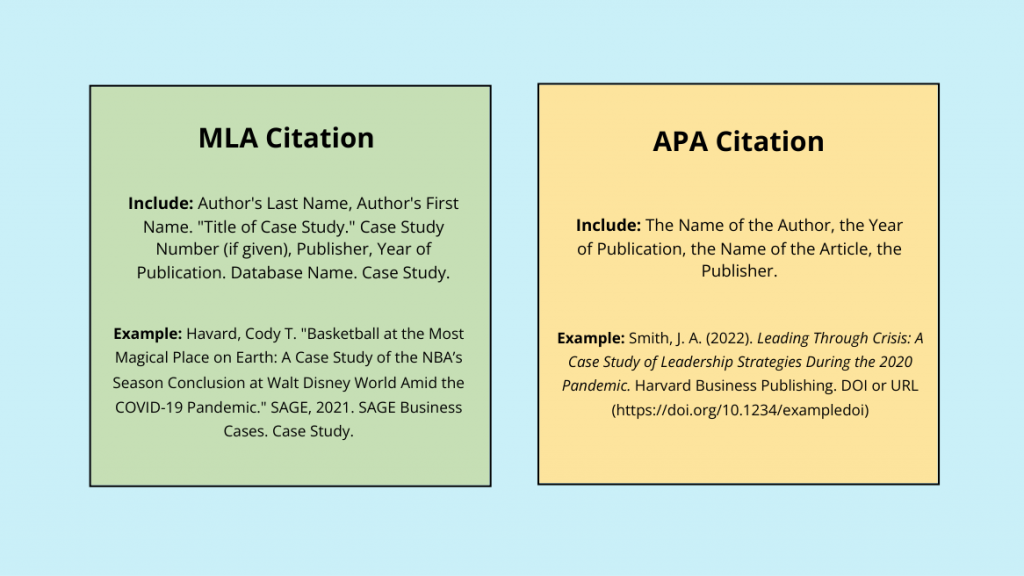
Still feeling overwhelmed about case studies? Be stress-free with the most convenient case study maker, which saves time and allows you to present data in the most attention-grabbing way.
Watch the video to create case studies in minutes with DocHipo’s case study maker.

Conclusion
To summarize, if you want to write a case study, start with a proper case study format, plan the case study, and finally write it with all the information in hand. Then, write a summary to provide an overview of your case study, and finally, add citations for reference.
Meanwhile, if you want to design a case study, Try DocHipo templates. Sign up to explore all the case study templates.
What is the structure of a case study?
A case study typically includes the following sections: Title, Introduction, Background, Problem Statement, Solutions, Results, and Conclusion. Each section serves to tell a comprehensive story of the business, from the issue at hand to the resolution and outcomes.
What are the 5 essential elements of a great case study?
The 5 essential elements are: 1) Clear Objective, 2) Detailed Background, 3) Specific Challenges, 4) Effective Solutions, and 5) Measurable Results. These components provide a compelling narrative that highlights the value delivered.
How to begin a case study?
Start a case study by defining the purpose and scope of the study. Introduce the subject, outline the problem, and provide background information to give readers context. This sets the stage for the detailed analysis that follows.
How to make an introduction in case study?
To craft a compelling introduction, briefly describe the subject, outline the problem they faced, and explain why the study is relevant. This section should grab the reader’s attention and make them interested in the rest of the study.
How to make a business case study?
A business case study should begin with a clear objective and background information. Identify the problem, explain the solutions implemented, and conclude with the results achieved. Use real data and quotes from stakeholders to enhance credibility.
How to write a case study step by step?
To write a case study step by step, start by identifying the case you want to explore and gathering relevant data on the subject. Outline the structure of your case study, then craft an engaging Introduction to set the context. Next, detail the Background and Challenges faced, followed by the Solutions applied. Share the Results and Conclusion to highlight the impact. Finally, edit and proofread your case study to ensure clarity and accuracy.

Turn your ideas into beautiful design
No prior design skill required

Talk to Sales
Wherever you are on your Dochipo journey, you can always get in touch.

Talk to Support
- Basics of Research Process
- Methodology
- How to Write a Case Study: Definition, Outline, Steps & Examples
- Speech Topics
- Basics of Essay Writing
- Essay Topics
- Other Essays
- Main Academic Essays
- Research Paper Topics
- Basics of Research Paper Writing
- Miscellaneous
- Chicago/ Turabian
- Data & Statistics
- Admission Writing Tips
- Admission Advice
- Other Guides
- Student Life
- Studying Tips
- Understanding Plagiarism
- Academic Writing Tips
- Basics of Dissertation & Thesis Writing
- Essay Guides
- Research Paper Guides
- Formatting Guides
- Admission Guides
- Dissertation & Thesis Guides
How to Write a Case Study: Definition, Outline, Steps & Examples

Table of contents
Use our free Readability checker
A case study is a research method that involves an in-depth examination of a particular subject, often a person, group, event, or organization. It's used to explore complex issues in real-world contexts. A case study can provide insights that might not be achieved with other research methods.
Are you struggling with writing a case study and don't know where to begin? You are not alone. Most students involved in the Psychology or Sociology field often find this task challenging. Especially if they are new to this research method. However, with the right structure and preparation, creating a case study paper will be a piece of cake.
After reading this article, you will be armed with all essential details including:
- Definition
- Case study types
- Basic structure
- Steps on how to write a case study
- Examples that worked.
Let’s dive right in!
What Is a Case Study: Definition
A case study is a research method that involves examining a specific instance to let researchers learn more about an individual, event, organization or concept. It is like a magnifying glass for studying real-life situations. By looking at a single example, we can learn more about complex issues and understand patterns.
Case studies are used in the fields like Psychology, Business, Statistics or Nursing. As a rule, students apply this research method when writing a dissertation or thesis .
Depending on the research question and the data needed to address a problem, case studies can involve various research methods.
Research Methods Applied in Case Studies
Case Study Example
A researcher is interested in studying the effects of a newly implemented teaching method on student performance. To find out, they observe a class of 30 students over one semester. The researcher compares the test scores from before and after the method was used, documenting its effectiveness. The study results showed that academic performance had improved by 11.5% since the new teaching method was implemented. The researcher concluded that this approach works well and can be generalized to a broader population.
Let's recap the main points.

What Is the Purpose of a Case Study?
The primary purpose of a case study is to gain insight into the real-world situations through the investigation and analysis of a single instance. This research design is often applied to meet such goals:
- Develop a better understanding of complex issues or phenomena
- Identify patterns and relationships
- Test hypotheses and theories in natural settings
- Provide practical solutions
- Illustrate best practices or successful strategies.
Every case study writer can customize their work to fit the needs of a specific discipline, as shown below.
Use of Case Studies
Looking for expert case study help ? Don't hesitate to contact our academic writers today to get the assistance you need. Our team of experts is ready to provide you with top-notch writings to help you achieve your academic or professional goals
Types of Case Studies
There are different types of case studies that scholars or students can bring into play. Each approach has its own focus and is chosen based on research objectives.
- Descriptive case studies This approach involves a detailed examination of a particular situation or phenomenon to understand it better. Here, researchers see the context, events, and processes that led to a particular outcome, and get a comprehensive picture of the situation.
- Explanatory case studies Explanatory method allows us to understand the "why" and “how” behind a particular event or phenomenon. As the name suggests, this type of case study seeks to test and explain the causal relationship between independent and dependent variables .
- Exploratory case studies Imagine being a detective and investigating a mystery or problem in its early stages. This is the main idea of an exploratory investigation. It helps to recognize key questions, potential patterns, and areas for further research. It's like peeling back the layers of an onion, revealing new insights and uncovering possible solutions.
- Intrinsic case studies Unlike other case study methods, an intrinsic approach is used to explore a unique instance. Here, researchers focus on a particular scenario in its own right, rather than trying to apply the outcomes to a broader population.
- Instrumental case studies This type of study examines one instance to shed light on a larger group or phenomenon. Instrumental technique is a good choice if you want to develop theoretical frameworks and obtain generalizable findings.
- Cumulative case studies While conducting cumulative research, students compile and synthesize information from multiple similar instances. Here, you combine the results of multiple studies to draw more generalized conclusions.
- Collective case reports Think of several individual instances being studied together to provide a broader understanding of a specific phenomenon. These instances are often connected by a common theme. This enables researchers to compare and contrast cases and uncover tendencies.
- Critical case studies Researchers use this method to explore exceptional instances that are particularly interesting or thought-provoking. Critical approach helps to analyze why a specific situation occurred and what could have been done differently.
Case Study Structure: Main Parts
When investigating any phenomenon, it’s important to organize your sections in a logical manner. A structure of a case study usually includes such components:
- Introduction This section is a place to present a case. Provide a brief overview of your instance, introduce your key research objectives and prepare the readers for further analysis.
- Problem identification By laying out a problem, you will be able to show the scope and significance of your topic. Identify the main issue that will be examined and build a clear statement of the problem.
- Background A properly established context sets the stage for research and lays a foundation for case evaluation. Offer relevant background information on the instance. This can be a historical, geographical or cultural context.
- Methodology Describe your methodology in research – approach, data collection methods and analysis techniques used in your investigation.
- Solution Now is the time to determine potential solutions to address the problem, and evaluate the pros and cons of each resolution. Make sure solutions are realistic.
- Results Once a case study is conducted, you should share your key findings. Mention any data or evidence that was collected and analyzed.
- Discussion This part of a case study is a perfect opportunity for analysis. Discuss the implications of your outcomes and draw conclusions
- Conclusion Summarize your main points, restate a problem and solutions, and offer final recommendations or next steps.

Case Study Outline
Before you create a case study, it’s a good idea to prepare an outline. It serves as a skeleton of your project. A well-structured outline of a case study helps organize your thoughts in a logical manner.
Below you can see an example of a basic template. Feel free to use it for inspiration.
General Outline
- Brief subject introduction
- Research purpose and objectives
- Necessary context
- Problem/issue
- Problem significance
- Subject/idea history
- Setting or environment description
- Key challenges, opportunities, or turning points
- Research methods used to gather information
- Data analysis methods
- Possible strategies
- Assessment of solutions
- Recommended solvents
- Major discoveries from the data analysis
- Implications
- Limitations/challenges
- Summary of key points
- Restatement of the problem and solution
- Final suggestions or next steps
Based on the sample template shown above, arrange your key ideas and highlight critical information. You may change the blocks to meet your assignment’s unique requirements.
Before You Start Writing a Case Study
Preparation is the key to success. To make your case study flawless, you need to establish your goal and plan. This will lay the foundation of the whole process before you begin writing.
Ensure you follow these 3 crucial steps before moving further.
1. Carefully Read the Instructions
Your professor may provide you with special requirements, case study rubric or exemplary works. The instructions may include details on preferred format, structure, word count, writing style or analysis techniques. Read given material attentively and make sure you fully understand the guidelines.
Get expertly crafted works to meet your academic needs. Buy case study from certified professionals and ace your assignments with ease.
2. Conduct Research
Researching is the most time-consuming part of writing a case study. Review relevant studies on the research topic to gain a deeper understanding of your subject. You may want to go through different sources and identify their strengths and limitations. Strive to build a bridge between your case study report and existing gaps.
Make sure to jot down all your ideas, opinions, notes or questions related to your research. This approach will help you build an outline and write a case study accordingly.
3. Gather Data
Now you are all set for the data collection process. Identify the most relevant type of information pertinent to your research question.
Consider using primary sources such as interviews, surveys or questionnaires. Secondary resources may include books, articles, case studies and public documents.
Your data must be accurate and reliable so double-check your research results before integrating them into your project.

How to Write a Case Study in 7 Steps?
Now that you are familiar with the preparation stages, it's time to dive into the writing process. Writing case studies can be challenging. But by following a structured approach, you can produce a clear and engaging work.
To create a strong project, it's important to carefully plan and execute each step of your flow, from identifying the research question to presenting your conclusions. Below we have prepared detailed guidelines on how to write a case study paper.

1. Introduce a Case Study
Start your case study introduction by presenting your subject and providing a brief overview of the research objectives. It's important to highlight the significance of your case and explain why it warrants examination. One way to do this is to focus on innovative aspects, such as a novel approach to a problem or a new technology. You can also emphasize the broader implications.
You should also preview a structure. This will give readers an idea of what to expect. Briefly describe your main points or provide a rough outline.
Case Study Introduction Example
Post-traumatic stress disorder (PTSD) is a debilitating condition that can arise in individuals who have experienced a traumatic event. In this case study, we examine the experiences of a patient who was diagnosed with PTSD following a car accident. Our analysis focuses on the patient's symptoms, including intrusive thoughts, hyperarousal, and avoidance behaviors. We also explore the treatments employed to manage these symptoms. By analyzing this case, we aim to provide insights into the challenges of treating PTSD and offer recommendations for improving therapeutic interventions for individuals suffering from this condition.
2. Describe a Problem
Before you get to the problem, provide context that explains the issue at hand. Identify the scope and impact of this problem. One efficient strategy of creating case studies that trigger attention is integrating examples or statistics. This helps to understand how severe this situation is.
Additionally, you may want to highlight any challenges or obstacles that have prevented a problem from being solved.
Example of Problem Description in a Case Study
John is a 28-year-old man who was involved in a serious car accident three months ago. Since then, he has been experiencing PTSD symptoms, including recurring nightmares, flashbacks, and feelings of anxiety. These symptoms have affected his work performance and relationships with family and friends. Despite seeking help from his primary care physician and attending therapy sessions, John has not experienced significant improvement. The challenge is to identify effective treatments that can help John manage his PTSD and improve his quality of life.
>> Read more: How to Write a Problem Statement
3. Discuss Research Methods
Research methods you apply will define how to make a case study. There are multiple ways to collect data. So your primary task here is to figure out what kind of information you want to obtain.
Your research strategy should align with your objectives. For instance, interviews can help capture detailed information from a small sample of people. On the other hand, surveys involve large groups of individuals. If you are using interviews or surveys, provide a list of questions participants were asked.
You can also do experiments to test out different theories or conduct document analysis to identify trends.
>> Learn more: What Is Experimental Design
Example of How to Describe Research Methods
In this research, both quantitative and qualitative data were utilized. 10 semi-structured interviews were conducted with participants who had experienced PTSD symptoms following a traumatic event. Additionally, data was collected from a survey of 253 individuals who had not been diagnosed with PTSD. We inquired about their experiences with trauma and the types of coping strategies they used to manage stress. Medical records from John's primary care physician were analyzed to track his progress over time. The combination of quantitative and qualitative data allowed for a comprehensive understanding of John's unique experiences with PTSD.
4. Offer Solutions to the Problem
The next stage involves coming up with potential solutions. Explain what strategies could be used to address the problem.
For example, if you write a case study on a business-related problem, solutions may involve implementing procedures to improve efficiency. Alternatively, in a healthcare niche, you will offer a new medication or therapy.
Be sure to provide evidence from your research or expert opinions to support your suggestions.
Here’s how to do a case study solutions section.
Example of Solution
One potential solution for addressing John's PTSD symptoms is cognitive-behavioral therapy (CBT). According to a study by Bisson and colleagues (2013), CBT has been found to be effective in reducing symptoms of PTSD in individuals who have experienced traumatic events. The therapist can work with John to identify and challenge negative thought patterns related to his traumatic experience and teach him coping skills to manage his anxiety and stress.
5. Present Your Key Results
Most scholars judge case study reports by research outcomes. You need to show that your solution works. Analyze collected data and share your most significant findings in your results section . This can be an increase in profits or a patient's health improvement.
When you write your case study outcomes, it is important to organize the information in a clear and concise manner. Use tables, graphs and charts to illustrate your data visually.
Provide a short summary of your results and their implications. But don’t just tell. You need to back up your research with evidence. If you used interviews, be sure to include any statistical analysis done for those results.
Example of Case Study Research Results
Our analysis showed that participants who received cognitive-behavioral therapy (CBT) reported a significant decrease in symptoms of post-traumatic stress disorder (PTSD), as compared to those who received no therapy. Specifically, the group who received CBT experienced a 35% reduction in symptoms. Meanwhile, the control group experienced no significant change. These findings suggest that CBT may be an effective treatment option for individuals with PTSD.
6. Conclude with Recommendations
A conclusion of a case study is where you wrap everything up and provide recommendations for further research. Sum up your key points and explain how they could be used to solve similar problems. You can also highlight any unexpected findings or insights that emerged during the study. Don’t forget to discuss any ethical considerations or limitations.
You need to create a lasting impression. For this, end a case study with a thought-provoking statement or call to action.
Case Study Conclusion Example
Our research highlighted the significant impact of PTSD on individuals who have experienced a traumatic event. The results suggested that cognitive-behavioral therapy and reprocessing therapy are effective treatments for PTSD. However, more research is needed to determine the long-term effects of these treatments. Additionally, the stigma surrounding mental health and seeking treatment remains a significant barrier to access to care. It is crucial for healthcare professionals and policymakers to address this issue and increase access to mental health services.
7. Proofread Your Case Study
Once you are done with writing a case study, you need to carefully review it. Keep an eye on these things when checking your work:
- Grammar mistakes Proofread your writing for typos and grammar errors. Feel free to use our Grammar Checker to make sure you got everything right.
- Clarity Check whether your work is readable and concise. Avoid long sentences and complex structures.
- Sources accuracy Make sure to check all sources for accuracy. It is also important to ensure that all reported data is up-to-date.
- Citations Ascertain whether all sources are properly cited and the same style is used consistently throughout your paper.
Case Study Format
Besides the content, it is also important to stick to a specific case study paper format. The layout of your paper should follow guidelines of the chosen citation style.
There are different ways to format a case study. Commonly used styles include APA, MLA, Chicago and Harvard. Each format presents specific requirements for formatting your text and references.
Check out our detailed guides listed below to learn more about each style.
>> How to Write a Paper in APA Format?
>> How to Do MLA Format?
>> How to Write a Chicago Style Paper?
Case Study Examples
Getting actual examples of case studies can be a great way to learn and understand how to write one. To help you out, we have collected several sample case study paper examples for different disciplines. Feel free to use these samples as inspiration when writing your own paper.
Case Study Writing Tips
With the right approach, your effort will reward you with an A+. In this section, we will list some actionable tips on how to write a good case study:
- Planning your work ahead Planning your work ahead Make sure to create an outline before you start writing and stick to it throughout the entire process.
- Arranging your data logically Break down complex information into chunks and use visual elements (tables, graphs, diagrams) to present it.
- Structuring your writing Use headings and subheadings to organize your content and make key points easy to access.
- Keeping your text simple Write your case study in an easy-to-read language and refrain from complex sentence structures.
- Remaining impartial Be objective in your analysis and avoid personal biases.
Mistakes to Avoid When Writing a Case Study
Even a small mistake can undermine your whole work. Here are some common pitfalls students fail to account for in their case studies:
- Focusing too much on the background Provide enough space for analysis of your problem and solution.
- Stuffing with direct quotes Quotes can be used as evidence in your paper. But relying on them too much will make it sound overly repetitive.
- Not referring to all sources Always cite your sources correctly and use only reliable data in your paper.
- Being vague Avoid general statements and be more specific while discussing your results and solutions.
- Failing to mention possible gaps Always consider ethical considerations or limitations.
Advantages and Disadvantages of Case Study
Using a case study approach as your research method has its own pros and cons. On one hand, it is an effective way to explore a particular issue in detail. On the other, there are certain limitations that come with this approach. Below we will cover both strengths and limitations of case studies.
Benefits of Case Study
A case study is like a seed that can grow into a fruitful tree, providing resolutions to intricate problems. Here are the biggest case study benefits you can use to your advantage:
- In-depth analysis Researchers can gather a lot of information on a specific topic or issue.
- Insights into elaborate issues Allows researchers to examine complex issues in a controlled manner.
- Real-life situations You are able to test theories or hypotheses in real-world settings.
- Comprehensive approach Researchers can collect both quantitative and qualitative data.
- Unique revelations This method can enlight on previously unexplored or understudied areas.
Limitations of Case Study
As with any research method, case studies have their fair share of drawbacks. Let's take a closer look at some of the most prevalent issues that can arise when using this approach.
- Limited generalizability Due to the small sample size and unique nature of each case, it can be difficult to generalize findings to a larger population.
- Observer bias Researchers may bring their own biases and perspectives, which can influence their results and interpretations.
- Time-consuming and expensive This approach requires significant time and resources to conduct, making it less feasible for some research questions.
- Lack of control In contrast to experimental research, case studies lack control over extraneous variables. This can make it difficult to establish cause-and-effect relationships.
- Subjectivity Collected data is often subjective and open to interpretation, which can introduce potential errors.
Case Study Paper Writing Checklist
Before you write a case study assignment, make sure to recap all the information you have learnt today. Refer to this checklist to ensure you are on the right track.
- checkbox I thoroughly researched my topic and gathered relevant information.
- checkbox A problem/issue is clearly defined.
- checkbox My case study structure is well-organized.
- checkbox I used appropriate research methods to gather data.
- checkbox My findings are well-supported by analysis and evidence.
- checkbox I discussed possible limitations and ethical considerations.
- checkbox The work offers recommendations for further research.
- checkbox My paper adheres to formatting guidelines required by my instructor.
Bottom Line on How to Write a Case Study
Writing a case study can be an incredibly challenging task for any student. However, with the right approach and tips, you can easily turn this daunting task into a pleasant experience.
We hope this article helped you understand how to write a case study. Remember to focus on the practical part and avoid overgeneralizing or cherry-picking data.
Our paper writing service is your best choice. We have helped thousands of students with their projects and would be glad to assist you, too. Our team of skilled writers is ready to help you complete your work upon ‘ write my case study ’ request.
Frequently Asked Questions
1. what is a case study in research.
A case study is a research method that involves an in-depth analysis of a particular subject. This approach most often focuses on a single event, person or group. It provides insight into the context of a problem and can be used to explore solutions to intricate issues.
2. What is the difference between a case study and a research paper?
The main difference between a case study and a research paper is in their scope. A case study explores a limited number of subjects, while research papers investigate multiple variables and/or draw conclusions from larger data sets. While both works contain evidence-based information, the focus and approach taken are quite different. Research papers are more general in nature, while case studies focus on narrow problems.
3. How long should a case study be?
The length of a case study varies depending on the type of assignment. Case studies intended for scholarly articles range from 3,000 to 4,0000 words or more. Meanwhile, if it’s a separate chapter in your MA or PhD dissertation, you will need to keep it between 8,000-15,000 words. Follow specific guidelines provided by your professor or institution.
4. Why is a case study important?
Case studies are an important research tool, as they provide detailed information on a particular issue. By exploring a single instance from multiple angles, researchers can uncover solutions to complicated problems that may not be immediately apparent. Using this method, scientists also test hypotheses and generate new theories.
5. What makes a good case study?
A good case study should be organized, well-researched, and contain evidence. Some characteristics of a case study include:
- Precise subject overview
- Thorough analysis that goes beyond surface-level information
- Examination of a single scenario from various perspectives
- Fact-based arguments
- Validated findings.
6. How to start a case study?
To start a case study, begin by carefully reading requirements and identifying the main problem to be addressed. Don't jump to conclusions or make assumptions – take it one step at a time. Once you have a clear understanding of your goal, gather relevant data. This includes doing research, interviewing people, and analyzing relevant documents.

Joe Eckel is an expert on Dissertations writing. He makes sure that each student gets precious insights on composing A-grade academic writing.
You may also like


IMAGES
VIDEO